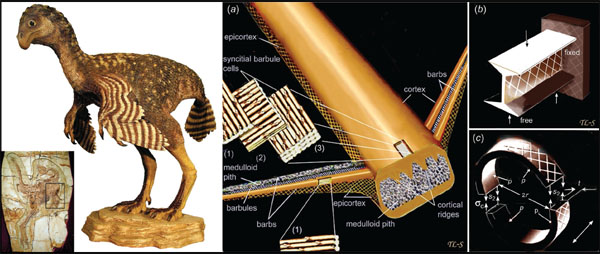Fig. (5) Left, the basal oviraptorosaur Caudipteryx, a secondarily flightless bird, with inset from [13], lower left, showing an actual fossil exhibiting a propatagium, proving that it had volant ancestors. Note the similarity in skull structure with Scansoriopteryx, (Fig. 1). Right, illustration by T. Lingham-Soliar showing the biomechanical complexity of feather structure, designed for aerodynamic function. Microstructural fiber model of feather rachis and barbs and classic engineering analogues. a. An exploded view of three fiber divisions of the rachidial cortex and one of the barb cortex (both in dorsal and ventral walls). The cortex is identified by the thick syncitial barbules cells (6–8 lm in diameter). The lateral walls of the rachis and barbs, the epicortex, are characterized by a crossed-fiber structure and absence of syncitial barbules cells. One barb shows cortex removed to expose the medullary pith cells. b. Diagrammatic view of rachis and barb as an I-beam (here, a cantilever) in which most material is concentrated in the upper (tension) and lower (compression) surfaces to resist maximum stresses–with the ‘‘web’’in the middle to resist shearing forces at 45±° c. Diagrammatic view of barb as a thin-walled pressure cylinder. Slice in latter shows circumferential stress (rc) is twice the longitudinal stress. Doubleheaded arrow long axis of cylinder (modified after Lingham-Soliar 2005b). From Lingham-Soliar T, Murugan N (2013) A New Helical Crossed-Fibre Structure of β-Keratin in Flight Feathers and Its Biomechanical Implications. PLoS ONE 2013; 8(6): e65849. doi:10.1371/journal.pone.0065849; Distribution under the Creative Commons License Deed, Attribution 2.5 Generic. Caudipteryx sculpture and inset copyright Stephen A. Czerkas, courtesy S. A. Czerkas.


